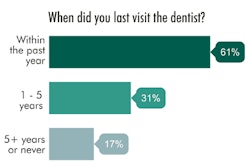Adult dental visits in the U.S. declined between 2000 and 2010, while children's increased during that same time period, according to new ADA research.
Surprisingly, the trend in reduced adult utilization predates the economic downturn that began in 2007, the association noted in a press release. The dental utilization gap between high- and low-income adults grew nationwide, while the gap between high- and low-income children shrank, which the authors attributed to greater efforts by states to improve dental coverage for children.
From 2000 to 2010, dental care utilization among low-income children increased in 47 states, according to ADA Health Policy Resources Center researchers. The authors cite such factors as improvements in some states' Medicaid programs, which result in increased dentist participation, the reauthorization of the Children's Health Insurance Program, and expansion of other the dental safety net programs targeting children.
Only two states -- Massachusetts and Virginia -- experienced statistically significant increases in utilization for both low-income adults and children.
The percentage of adults who reported going to the dentist in the prior year has been declining since before the economic downturn, dropping from 41% in 2003 to 37% in 2010, according to the ADA. Those in the 35 to 49 age group had the largest decline in utilization, dropping from 43% in 2003 to 38% in 2010.
Adult dental care utilization declined across the spectrum during the 2000s but was most pronounced among lower-income adults. For middle-income adults, utilization declined from 38% in 2003 to 34% in 2010. Utilization among higher-income adults decreased from 54% to 51%.



















